Fujitsu Client Computing WB0098 Tablet Computer User Manual Manual Rezel EN draft for FJ 151124 ver02
Fujitsu Limited Tablet Computer Manual Rezel EN draft for FJ 151124 ver02
Contents
- 1. Manual_Rezel_EN_draft_ for FJ_151124 ver02
- 2. Pcikup_FCC_IC_Draft2-B5FK-7101-01ENZ0-00_en-us_160314
Manual_Rezel_EN_draft_ for FJ_151124 ver02

ii
Copyright
Copyright
Fujitsu Limited has made every effort to ensure
the accuracy and completeness of this document.
However, as ongoing development efforts are
continually improving the capabilities of our
products, we cannot guarantee the accuracy
of the contents of this document. We disclaim
liability for errors, omissions or future changes.
LifeBook is a trademark of Fujitsu Limited.
Microsoft, Windows, MS, Windows XP,
Windows 7 and Windows 8 are registered
trademarks of the Microsoft Corporation of the
United States in the United States and other
countries.
Phoenix is a registered trademark of Phoenix
Technologies Corporation of the United States.
ExpressCard™ module technology is a registered
trademark of Personal Computer Memory Card
International Association.
Copyright© Microsoft Corporation 2013,
All rights reserved.
Copyright© Phoenix Technologies 2013, Ltd., All
rights reserved.
Other product names are trademarks or registered
trademarks of their respective companies.
Copyright © Fujitsu Limited 2013. All rights
reserved. No part of this publication may be
copied, reproduced or translated, without the
prior written consent of Fujitsu Limited. No part
of this publication may be stored or transmitted
in any electronic form without the written consent
of Fujitsu Limited.
This device complies with Part 15 of the FCC
rules. Operations are subject to the following
two conditions:
(1) This device may not be allowed to cause harmful
interference.
(2) This device must accept any interference
received, including interference that may cause
undesired operation.
Manufactured under license from
DTS Licensing Limited. DTS, the
Symbol, & DTS and the Symbol
together are
registered trademarks, and DTS Boost is a
trademark of DTS (BVI) Limited (in Hong Kong
and China) and DTS, Inc. (outside of Hong Kong
and China).
© DTS, Inc. All Rights Reserved.
Website: hk.fujitsu.com/pc
DECLARATION OF CONFORMITY
according to FCC Part 15

ii
IMPORTANT SAFETY
INSTRUCTIONS
1. Read these instructions carefully. Save these
instructions for future reference.
2. Follow all warnings and instructions marked on
the product.
3. Unplug this product from the wall outlet before
cleaning Do not use liquid cleaners or aerosol
cleaners. Use a damp cloth for cleaning.
4. Do not use this product near water.
5. Do not place this product on an unstable cart,
stand or table. The product may drop, causing
serious damage to the product.
6. Slots and openings in the cabinet and the back
or bottom are provided for ventilation; to ensure
reliable operation of the product and to protect
it from overheating, these openings must not be
blocked or covered. The openings should never
be blocked by placing the product on a bed,
sofa, rug or other similar surface. This product
should never be placed near or over a radiator
or heat register or in a built-in installation unless
proper ventilation is provided.
7. This product should be operated from the type of
power indicated on the marking label. If you are
not sure of the type of power available, consult
your dealer or local power company.
8. Do not allow anything to rest on the power cord.
Do not locate this product where persons will
walk on the cord.
9. If an extension cord is used with this product,
make sure that the total ampere rating of the
equipment plugged into the extension cord
does not exceed the extension cord ampere
rating. Also, make sure that the total rating of
all products plugged into the wall outlet does
not exceed 15 amperes.
10. Never push objects of any kind into this
product through cabinet slots as they may
touch dangerous voltage points that could
result in a fi re or electric shock. Never spill
liquid of any kind on the product.
11. Do not attempt to service this product yourself,
as opening or removing covers may expose
you to dangerous voltage points or other
risks. Refer all servicing to qualifi ed service
personnel.
12. Unplug this product from the wall outlet and
refer servicing to qualifi ed service personnel
under the following conditions:
a. When the power cord or plug is damaged or
frayed.
b. If liquid has been spilled into the product.
c. If the product has been exposed to rain or
water.
d. If the product does not operate normally
when the operating instructions are followed.
Adjust only those controls that are covered
by the operating instructions since improper
adjustment of other controls may result in
damage and will often require extensive work
by a qualifi ed technician to restore the product
to normal condition.
e. If the product has been dropped or the cabinet
has been damaged.
f. If the product exhibits a distinct change in
performance, indicating a need for service.

iii
13. CAUTION: When replacing the battery,
be sure to install it with the polarities in
the correct position. There is a danger of
explosion if the battery is replaced with
an incorrect type or is mistreated. Do not
recharge, disassemble or dispose of in fi re.
Replace only with the same or equivalent
type recommended by the manufacturer.
Dispose of the used battery according to
the manufacturer’s instructions.
14. Use only the proper type of power cord set
(provided in the accessories box) for this unit. It
should be detachable type and with respective
certifi cation.
Copyright

iv
Changes or modifi cations not expressly
approved by Fujitsu could void this user’s
authority to operate the equipment.
CAUTION
FCC NOTICES
Notice to Users of Radios and Television
These limits are designed to provide reasonable
protection against harmful interference in a
residential installation. This equipment generates,
uses, and can radiate radio frequency energy
and, if not installed and used in accordance with
the instructions, may cause harmful interference
to radio communications. However, there is no
guarantee that interference will not occur in a
particular installation. If this equipment does
cause harmful interference to radio or television
reception, which can be determined by turning
the equipment off and on, the user is encouraged
to try to correct the interference by one or more
of the following measures:
• Reorient or relocate the receiving antenna.
• Increase the separation between the equipment
and receiver.
• Connect the equipment into an outlet that is on a
different circuit than the receiver.
• Consult the dealer or an experienced radio/TV
technician for help.
Shielded interconnect cables must be employed
with this equipment to ensure compliance with
the pertinent RF emission limits governing this
device.
Notice to Users of the US Telephone
Network*
Your LifeBook notebook may be supplied with
an internal modem which complies with Part
68 of the FCC rules. On this notebook is a label
that contains the FCC Registration Number and
the Ringer Equivalence Number (REN) for this
equipment among other information. If requested, the
user must provide their telephone company with
the following information:
1. The telephone number to which the notebook
is connected.
2. The Ringer Equivalence Number (REN) for this
equipment.
3. That the equipment requires a standard
modular jack type USOC RJ-11C which is
FCC Part 68 compliant.
4. The FCC Registration Number.
This equipment is designed to be connected to
the telephone network or premises wiring using
a standard modular jack type USOC RJ-11C
which is FCC Part 68 compliant and a line cord
between the modem and the telephone network
with a minimum of 26AWG.
The REN is used to determine the number of
devices that you may connect to your telephone
line and still have all of those devices ring when
your number is called. Too many devices on one
line may result in failure to ring in response to
an incoming call. In most, but not all, areas the
sum of the RENs of all of the devices should
not exceed fi ve (5). To be certain of the number
of devices you may connect to your line, as
determined by the RENs, contact your local
telephone company.
If this equipment causes harm to the telephone
network, your telephone company may
discontinue your service temporarily. If possible,
they will notify you in advance. If advance notice
is not practical they will notify you as soon as
possible. You will also be advised of your right to
fi le a complaint with the FCC.
This fax modem also complies with fax branding
requirements per FCC Part 68.
Your telephone company will probably ask you
to disconnect this equipment from the telephone
network until the problem is corrected and you
are sure that the equipment is not malfunctioning.
* For model with modern only.

v
DOC (INDUSTRY CANADA)
NOTICES
Notice to Users of Radios and Television
This Class B digital apparatus meets all requirements
of the Canadian Interference Causing Equipment
Regulations.
Notice to Users of the Canadian Telephone
Network*
The Canadian Industry Canada label identifi es
certifi ed equipment. This certifi cation means that the
equipment meets certain telecommunications
network protective, operational, and safety
requirements. The Department does not guarantee
the equipment will operate to the user’s satisfaction.
LifeBook notebooks are supplied with an internal
modem which complies with the Industry Canada
certification standards for telecommunication
network protection and safety requirements. Before
connecting this equipment to a telephone line the
user should ensure that it is permissible to connect
this equipment to the local telecommunication
facilities. The user should be aware that compliance
with the certifi cation standards does not prevent
service degradation in some situations.
Repairs to telecommunication equipment should
be made by a Canadian authorized maintenance
facility. Any repairs or alterations not expressly
approved by Fujitsu or any equipment failures may
give the telecommunication company cause to
request the user to disconnect the equipment from
the telephone line.
The connecting arrangement code for this
equipment is CA11A.
The Load Number assigned to each telephone
terminal device denotes the percentage of the total
load to be connected to a telephone loop or circuit
which is used by the device to prevent overloading.
The termination on a loop may consist of any
combination of devices such that the total of the
load numbers of all devices does not exceed 100.
* For model with modem only
This equipment may not be used on coinoperated
telephones provided by your telephone
company. Connection to party lines is subject
to state tariffs. Contact your state’s public utility
commission, public service commission or
corporation commission for more information.
This equipment includes automatic dialing
capability. When programming and/or making
test calls to emergency numbers:
• Remain on the line and brie y explain to the
dispatcher the reason for the call.
• Perform such activities in off-peak hours, such as
early morning or late evening.
FCC rules prohibit the use of non-hearing aid
compatible telephones in the following locations
or applications:
• All public or semipublic coin-operated or credit
card telephones.
• Elevators, highways, tunnels (automobile,
subway, railroad or pedestrian) where a person
with impaired hearing might be isolated in an
emergency.
• Places where telephones are specically installed
to alert emergency authorities such as fire, police
or medical assistance personnel.
• Hospital rooms, residential health care facilities,
convalescent homes and prisons.
• Workstations for the hearing impaired.
• Hotel, motel or apartment lobbies.
• Stores where telephones are used by patrons to
order merchandise.
• Public transportation terminals where telephones
are used to call taxis or to reserve lodging or rental
cars.
• In hotel and motel rooms as at least ten percent
of the rooms must contain hearing aid compatible
telephones or jacks for plug-in hearing aid
compatible telephones which will be provided to
hearing impaired customers on request.
Copyright

vi
ENERGY STAR®
Compliance
Notice to Users of Radios and
Television
(The following is pending
certificationattime o f publication). Your Fujitsu system
is an ENERGY STAR® qualifi ed mobile PC. By
choosing a computer with the latest energysaving
technology, you’re helping to preserve our
environment for future generations.ENERGY STAR is
a joint program of the U.S. Environmental Protection
Agency, U.S. Department of Energy, Natural
Resources Canada, and other governments around
the world helping us save money while protecting the
environment through energy effi cient products and
practices. With energy costs and global warming top-
of-mind for consumers, Fujitsu is committed to offering
solutions that help consumers conserve energy and
improve the quality of our environment.
Sleep Mode:
You will notice that your computer is initially set
so that the display turns off after 15 minutes
of user inactivity, and the computer goes into
Sleep mode after 20 minutes of user inactivity.
When going into Sleep mode, the computer also
reduces the speed of any active Ethernet network
links. To “wake” the computer from Sleep mode,
press the Suspend/ Resume Button.
Energy saving benefits:
Fujitsu ENERGY STAR qualifi ed mobile PCs
use about half as much electricity as standard
equipment – saving half in utility costs. But
more than that, ENERGY STAR also makes a
difference for the environment. Did you know that
the average house can be responsible for twice
the greenhouse gas emissions as the average
car? That’s because every time you ip on a light
switch, run your dishwasher, or turn on your PC,
you use energy, which means more greenhouse
gas emissions from power plants. So the more
energy we can save through energy effi ciency,
the more we help to reduce greenhouse gases
and the risks of global warming.
To learn more about the important ENERGY
STAR program, visit: www.energystar.gov.
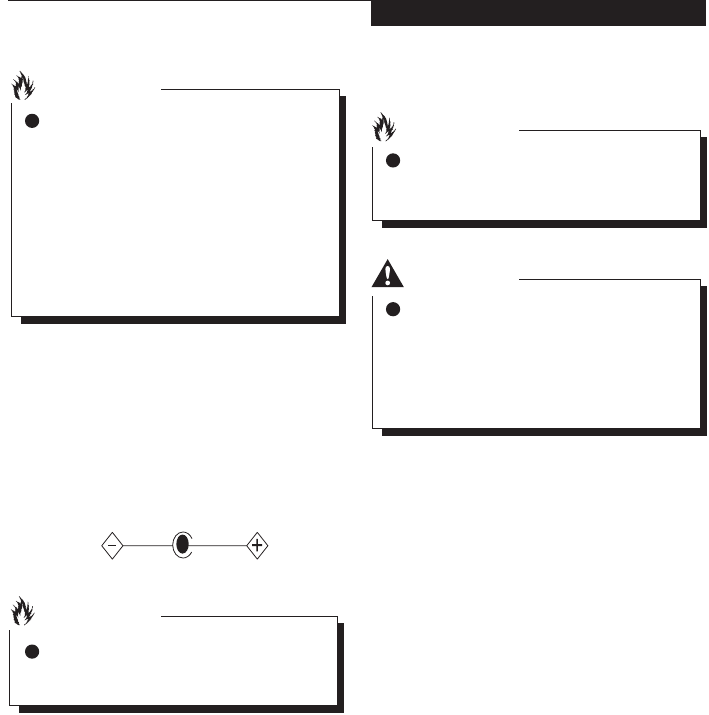
vii
UL Notice
* Please check with local distributor for actual
Proper Disposal of Battery
Under federal, state or local law, it may be illegal
to dispose of batteries by putting them in the
rubbish bins or trash cans. Please take care
of our environment and dispose of batteries
properly. Check with your local government
authority for details regarding recycling or
disposing of unwanted batteries.
For Authorized Repair Technicians Only
Copyright
CAUTION
CAUTION
WARNING
CAUTION
For safety, users should ensure that the
electrical ground of the power utility,
the telephone lines and the metallic
water pipes are connected together.
Users should NOT attempt to make
such connections themselves but
should contact the appropriate electric
inspection authority or electrician. This
may be particularly important in rural
areas.
To reduce the risk of fire, use only #26
AWG or larger telecommunications line
cord.
For continued protection against risk of
fire, replace only with the same type and
rating fuse.
Danger of explosion if Lithium (CMOS)
battery is incorrectly replaced. Replace
only with the same or equivalent type
recommended by the manufacturer.
Dispose of used batteries according to
the manufacturer’s instruction.
This unit requires an AC adapter to operate.
Use only UL Listed adapter, output rating
19VDC 3.42A* and 4.74A*. Refer to the
illustration below forthe correct AC Adapter
output polarity:

viii
NOTE ON USE REQUIRED HIGH
SAFETY
This product is designed and manufactured
for general use, including general offi ce use,
personal use, household use and ordinary
industrial use.
This product is not designed for or intended for
use under dangerous (fatal) conditions, unless
extreme safety precautions are implemented.
Do not use this product without implementing
high-level safety precautions.
Failure to follow this warning may result in
death, personal injury, severe physical damage
or other loss, if used in or near any or more of
the following:
• nuclear reaction control system in a nuclear
facility
• automatic ight control system in an airplane
or other ight control system
• mass transport control system
• medical instruments for life support system
• missile launching control for weapon system
NOTE ON BACKUP DATA
Please make a backup of the Operating System,
any software programs, and created fi les (and
update regularly).
If you send this product to Fujitsu, or any of
its affi liates, suppliers, service providers or
resellers for repair, Fujitsu does not guarantee
the data integrity. It is your responsibility to back
data up beforehand.
Fujitsu does not assume any obligation for
compensation for damages, data integrity, or
restoration, etc., if your data is lost for any
reason, except as written in the warranty.

ix
AUSTRALIAN REGULATIONS
Important Health and Safety Information
This notebook complies with the relevant safety
regulations for data processing equipment. If you
have questions about using your notebook in a
particular area, please contact your sales outlet
or our Hotline/Help Desk.
Additional safety notes for devices with
modem
WARNING
FOR SAFETY REASONS, ONLY CONNECT
EQUIPMENT WITH A TELECOMMUNICATIONS
COMPLIANCE LABEL. THIS INCLUDES
CUSTOMER EQUIPMENT PREVIOUSLY
LABELLED PERMITTED OR CERTIFIED.
Connection of Non Certified / Approved
peripherals may result in the equipment
operating outside the Australian EMI
Standards.
Modems connected to the Australian
telecommunications network must be operated
in accordance with the Labelling Notice. This
modem has been specifically configured to
ensure compliance with the ACMA Standards.
Do not adjust your modem or software outside
the values indicated below. To do so would
result in your modem being operated in a non-
compliant manner.
The unit shall be connected to Telecommunication
Network through a line cord, which meets the
requirements of ACMA AS / ACIF S008:2006.
The equipment shall be powered through an
Australian Approved mains cord set. When the
Secondary Landscape Orientation of the tablet
is held close to the body, the antenna must be
in closed condition to avoid physical damage to
the Antenna.
Call Attempts / Retries:
Applications software shall be confi gured so
that no more than 3 attempts are made to
establish a connection to a given number (Note:
if the modem can detect service tones, up to 10
attempts can be made). If the call sequence is
unsuccessful, there shall be a delay of at least
30 minutes before attempting to call the number
again.
Failure to set the modem and any application
software used with the modem, to the
values shown above will result in the modem
being operated in a non-compliant manner.
Consequently, this would be in violation of
the Labelling Notice for this equipment and
the Telecommunications Act 1997 prescribes
penalties for the connection of
non-compliant equipment.
Copyright

x
NEW ZEALAND WARNINGS
The grant of a Telepermit for any item of terminal
equipment indicates only that Telecom has
accepted that the item complies with minimum
conditions for connection to its network. It
indicates no endorsement of the product by
Telecom, nor does it provide any sort of warranty.
Above all, it provides no assurance that any
item will work correctly in all respects with
another item of Telepermitted equipment of a
different make or model, nor does it imply that
any product is compatible with all of Telecom’s
network services.
This equipment is not capable under all operating
conditions of correct operation at the higher
speeds for which it is designed. 56 KBPS
connections are likely to be restricted to
lower bit rates when connected to some PSTN
implementations. Telecom will accept no
responsibility should diffi culties arise in such
circumstances.
Immediately disconnect this equipment should it
become physically damaged, and arrange for its
disposal or repair.
This equipment shall not be used in any manner,
which could constitute a nuisance to other
Telecom customers.
This equipment shall not be set to make
automatic calls to the Telecom “111” Emergency
Service.
This device is equipped with pulse dialing while
the New Zealand standard is DTMF tone dialing.
There is no guarantee that Telecom lines will
always continue to support pulse dialing. It is
strongly recommended that pulse dialing is not
used.
Some parameters required for compliance
with Telecom’s Telepermit requirements are
dependent on the equipment (PC) associated
with this device. The associated equipment shall
be set to operate within the following limits for
compliance with Telecom’s Specifi cations:
For repeat calls to the same number.
There shall be no more than 10 call attempts
to the same number within any 30 minute
period for any single manual call initiation
and the equipment shall go on-hook for a
period of not less than 30 seconds between
the end of one attempt and the beginning of
the next attempt.
For Automatic calls to different numbers.
The equipment shall go on-hook for a period
of not less than 5 seconds between the end
of one attempt and the beginning of the next
attempt.
For Automatically answered Incoming
Calls.
Incoming calls shall be answered between 3
and 30 seconds from the start of the ringing.
For correct operation, the total of the RNs of all
devices connected to a single line at anytime
should not exceed 5. The RN of this Equipment
is 0.5.
WARNING:
CONNECTION OF NON CERTIFIED/
APPROVED PERIPHERALS MAY RESULT IN
THE EQUIPMENT OPERATING OUTSIDE THE
NEW ZEALAND EMI STANDARDS.

xi
TROUBLESHOOTING .......................... 21
Identifying the Problem 21
Specific Problems 21
Troubleshooting Table 22
NAMES OF THE PARTS
AND THEIR FUNCTIONS 1
Front features of the notebook 1
Exterior features: Side view 3
Exterior features: Bottom view
of the notebook 5
STATUS INDICATOR LED 6
Wireless LAN / Bluetooth Indicator 6
Power Indicator 6
Battery Charging Indicator 6
Disk Drive Access Indicator 6
Num Lock Indicator 6
Caps Lock Indicator 6
7
7
8
RUNNING THE Tablet PC
ON ITS BATTERY
Recharging the battery
Running the notebook on its battery
Checking the power level of the battery 8
POWER MANAGEMEN 10
Power/Suspend/Resume Button 10
Suspend Mode 10
Hibernation (Save-To-Disk) Feature 11
Windows Power Management 12
Power Off 12
POWER SOURCES 13
Connecting the Power Adapter 13
Power On 14
Power Off 14
GETTING TO START DVD
SHARING APPLICATION 15
Table of Contents
Table of Contents
NOTE:
A copy of LifeBook User’s Manual is located in
your Microsoft Windows OS or you can find it
in Fujitsu’s website at http:hk.fujitsu.com/pc.
You can use this LifeBook User’s Manual to find
out more information about the functions and
features of your notebook.

xii
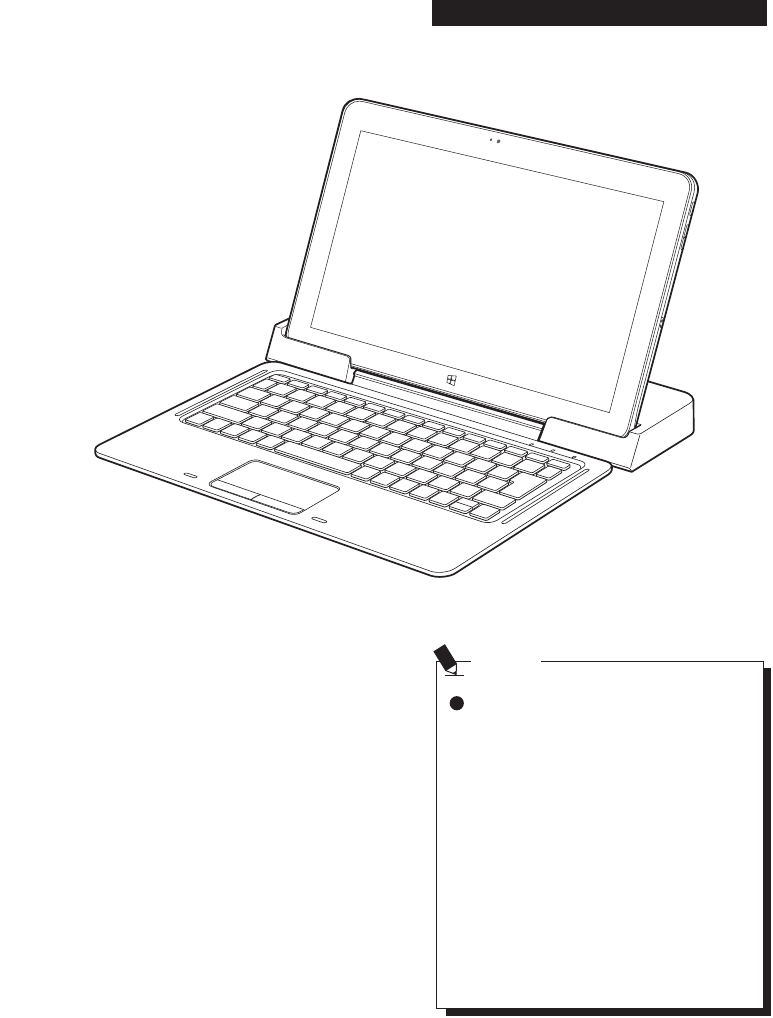
1
1
2
3
4
6
7
(This picture is for illustration purpose only and may look different from the actual unit)
NAMES OF THE PARTS
AND THEIR FUNCTIONS
Front and right features of
the Tablet, Docking-Keyboard,
and Docking-Station
1. HD Camera
The location of the high defi nition camera.
2. Display Panel
The display screen of the notebook.
3. Power and Suspend/Resume Button
This button allows you to power on or off the
notebook. You can use also this button to
suspend notebook activity without turning off
the power to it and to resume the notebook
from suspend mode.
The phenomena described below are
characteristics of LCD panels and do not
indicate that LCD panels are defective.
• The TFT color LCD screen of your
notebook, composes of more than
2,350,000 picture elements (number
of dots when the screen resolution
is set at 1920 by 1080 pixels). It
was manufactured using advanced
technologies. For technical reasons,
LCD screen may have pixels that do not
light and pixels that are always lit.
• LCD panels may display slight varying
colors and uneven density.
POINT
Getti ng to Kno w Your L ife Boo k
5
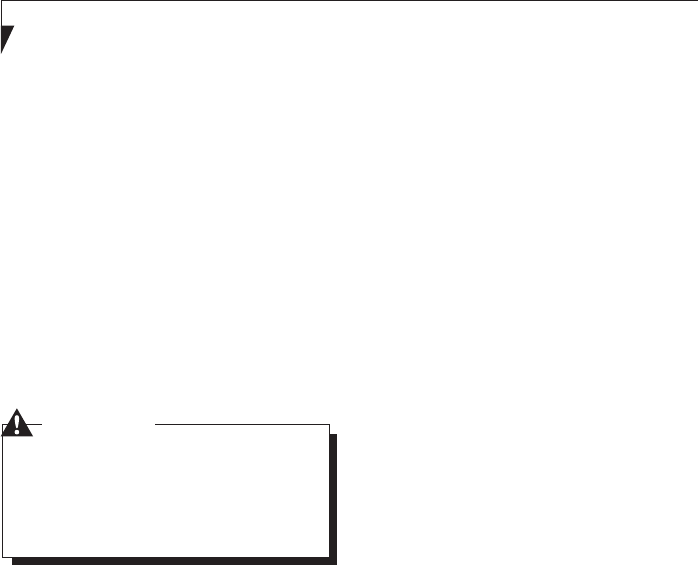
2
4. Volume up/down buttons
The built-in dual speakers provide stereo
sound.
6. Keyboard
A full-function keyboard with dedicated
Windows keys.
7. Touch Pad
It allows you to control the display cursor
(mouse pointer).
WARNING
Spill resistant keyboard does not imply the
keyboard is water-proof. If liquid is spilled
onto the keyboard, power off your notebook
immediately and turn the notebook upside
down to drain off the liquid.
5. Windows button
A button on glass for executing
windows button function
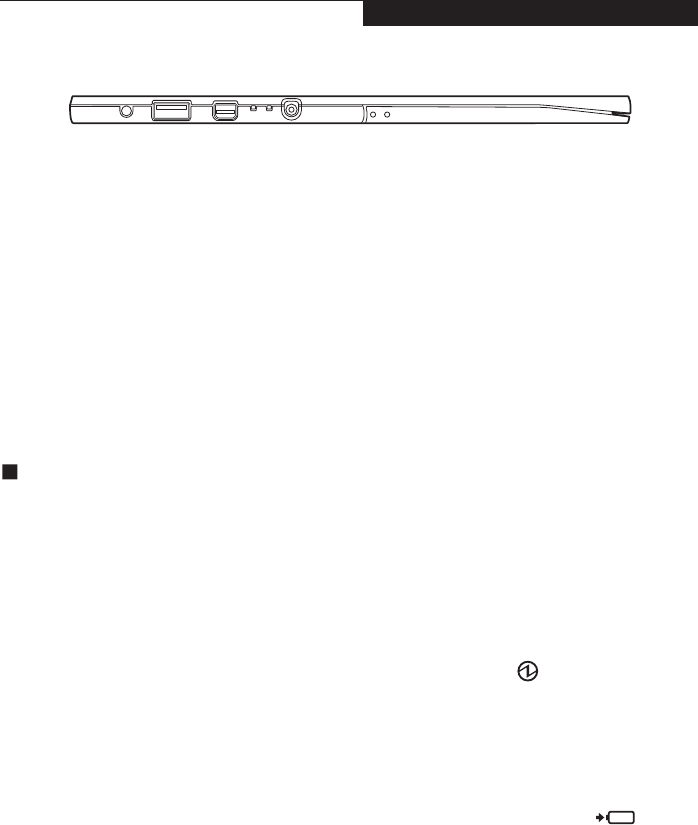
3
Getti ng to Kno w Yo ur LifeB ook
(This picture is for illustration purpose only and may look different from the actual unit)
Exterior features: Side view
Left view of the Tablet PC
USB 3.0 Port
The USB 3.0 port allows you to connect
Universal Serial Bus devices. USB 3.0 devices
transfer data at up to 5Gbps and is backward
compatible with USB 2.0 devices.
With USB charging function.
HDA Jack
It allows jack sensing of the following audio
input/output devices.
• Headphone
It allows you to connect a Ø3.5mm
headphone to it. There are commercially
available headphones with different types of
connector. Please check the compatibility of
these headphones before purchase.
• Microphone Jack
Connect an external microphone. The
internal microphone is disabled,when you
plug in an external microphone.
2.
1.
1234
5 6
DC Power Jack
4.
Video/audio terminal (miniDisplayPort)
You can use this port connect to a Monitor
via optional miniDisplayPort to HDMI
cable or miniDisplayPort to VGA cable.
3.
5.Power Indicator ( )
This indicator turns on when there is power
to the notebook.
It turns off when the notebook is powered off.
This indicator will blink if the notebook is put
in suspend mode.
6.Battery Charging Indicator ( )
This indicator turns on when internal battery
is being charged.
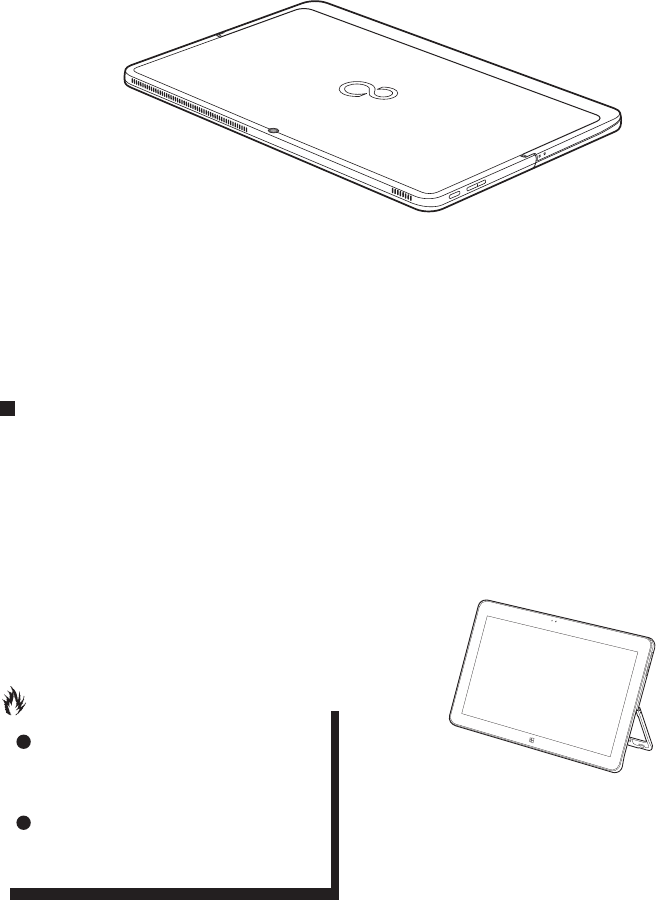
4
(This picture is for illustration purpose only and may look different from the actual unit)
Bottom view of the Tablet PC
CAUTION
Do not obstruct the air vents while the
system is running; doing so could cause
your system to overheat.
Surface temperature may be high during
and after operation. Do not touch the
surface.
1. 5M pixels Camera Stand for tablet
You can open stand by hand like as
below, for keep tablet standing with it.
Angle between tablet and stand is
adjustable, and the maximum angle is
90degree.
3.
2
1
3
2. Air Vents
The air vents are used to cool the system
to prevent overheating.
Up to 90 degree
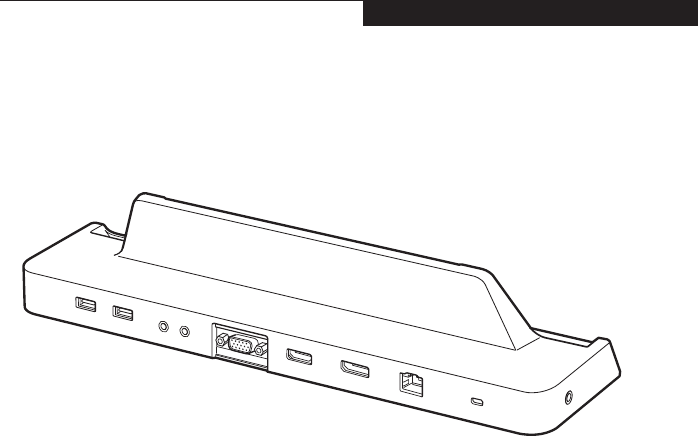
5
(This picture is for illustration purpose only and may look different from the actual unit)
Exterior features: Back-side view
of Docking-Station
Getti ng to Kno w Yo ur LifeB ook
4.Video output (Analog RGB)
Analog RGB output for external monitor
9
23
4
11
567
8
USB 3.0 Port
The USB 3.0 port allows you to connect
Universal Serial Bus devices. USB 3.0 devices
transfer data at up to 5Gbps and is backward
compatible with USB 2.0 devices.
1.
2Headphone Jack
It allows you to connect a Ø3.5mm
headphone to it. There are commercially
available headphones with different types of
connector. Please check the compatibility of
these headphones before purchase.
3Microphone Jack
Connect an external microphone. The
internal microphone is disabled,when you
plug in an external microphone.
5.Video/audio terminal (HDMI)
Digital Video/audio terminal for external
monitor, supporting HDMI 1.4
specification.
6.Video/audio terminal (Displayport)
Digital Video/audio terminal for external
monitor, supporting Displayport 1.2a
supecification.
7.LAN Port
This Port allows you to connect to a LAN
(local area network) using an optional LAN
cable.
8.A hole for Security wire
DC Power Jack
9.
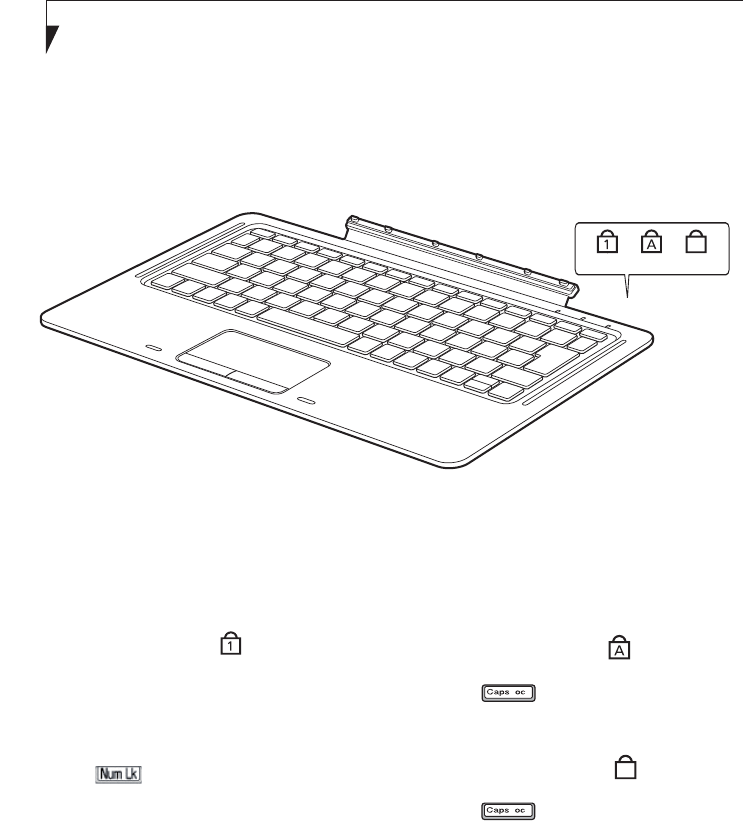
6
STATUS INDICATOR Docking-Keyboard LED
1.Num Lock Indicator ( )
This indicator lights up when the keyboard is
locked in Num Lock mode. (You can use the
keyboard as a ten-digit keyboard when the
Num Lock mode is turned on).
You can toggle the Num Lock mode by using
the [ ] key.
2.Caps Lock Indicator ( )
You can toggle the Caps Lock mode by using
the [ ] key.
(This picture is for illustration purpose only and may look different from the actual unit)
Exterior features: Front view of
Docking-Keyboard
23
1
3.
Scroll Lock Indicator ( )
You can toggle the Scroll Lock mode by using
the [ ] key.
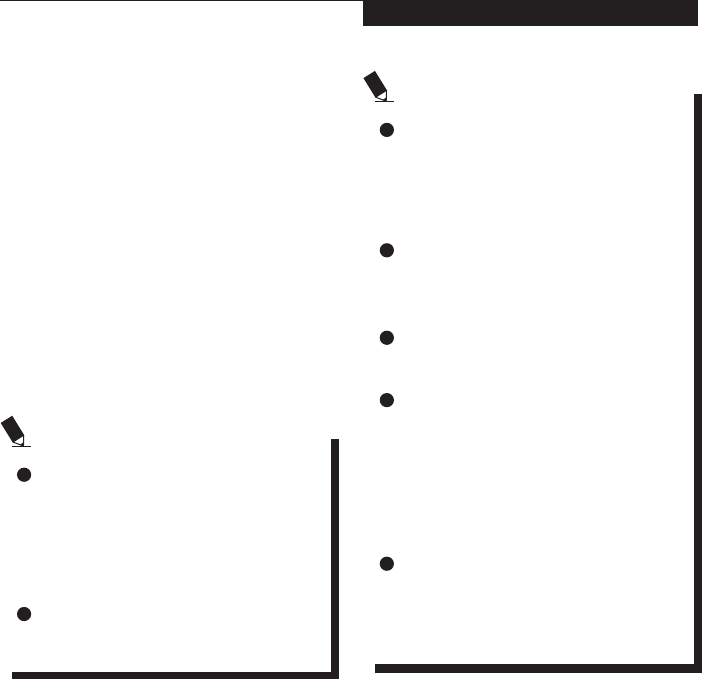
7
Getting to Know Your LifeBook
RUNNING THE Tablet PC
ON ITS BATTERY
Recharging the battery
1. Connect the AC adapter to your notebook.
The moment you connect an AC adapter to
your notebook, the notebook begins to charge
the internal standard battery pack.
2. When the battery level indicator turns off
after the battery is completely charged,
(while the notebook is in off mode)
disconnect the AC adapter from the
notebook.
Before using the supplied battery pack
for the very first time after purchase,
remember to charge it fully. If a charged
battery has not been recharged for more
than a month, charge it fully before using
it.
When the battery is fully charged while
the notebook is in power off mode, the
Battery Level LED indicator turns off.
When the battery is 90% or more
charged, it cannot be recharged even
if the AC adapter is connected. The
battery can be recharged when its
power level (i.e. remaining battery life)
is 89% or less.
When a notebook is turned off, the
Battery Level LED indicator goes off
immediately if the battery is completely
charged.
The chargeability of the battery degrades
when it is used in an extremely hot or cold
place.
When the battery is very hot, for
example, immediately after long usage
of the notebook, the battery protection
feature may be activated to prevent the
battery from being recharged. When the
temperature decreases, the notebook
automatically begins to charge the
battery.
When an optional modular bay battery
is installed, it is charged along with
the internal standard battery. (Optional
modular bay battery is applicable to
selected models only.)
POINT
POINT
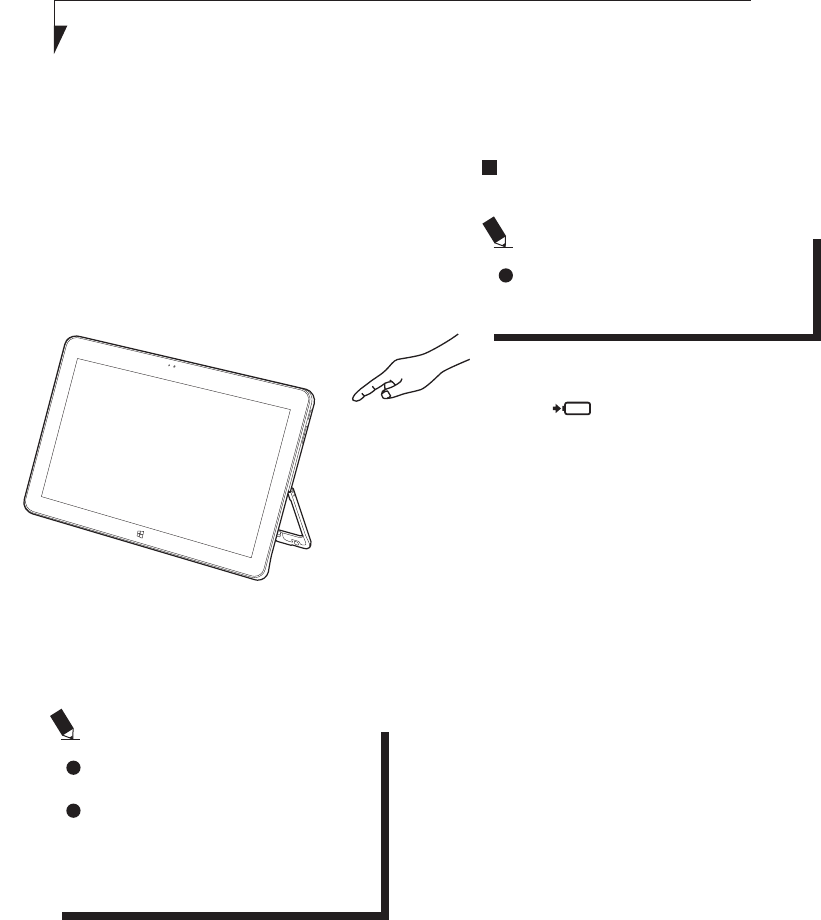
8
Running the Tablet PC
on its battery
This section describes the steps to run the
notebook on its internal standard battery.
1. Disconnect the AC adapter from your
notebook and press the power button.
Checking the power level
of the battery
Checking the power level of the
battery
1. Built-in Battery Pack Charging
Lamp ( )
This lamp indicates charging status of builtin
battery when AC adaptor is connected to
PC.
• Blue lamp is lit
Charging completed.
• Amber lamp is lit
Charging
• Blue and Amber lamp flashes
Charging stopped (due to battery
temperature alarm, etc. [Note 1])
• OFF
No charging due to disconnected AC
adaptor.
(This picture is for illustration purpose only and may look
different from the actual unit)
The power level of the battery decreases
faster when it is used in a cold place.
The chargeability of the battery decreases
after it has been used over a long period
of time. If the battery runs down very fast,
replace it with a new battery.
POINT
When the power is turned off, the status
display LEDs are all OFF except for
during battery charging.
POINT
Power button

9
Getting to Know Your LifeBook
The use of a weak battery may result
in lost of data you are currently working
on. When the battery runs low, connect
the AC adapter to your notebook as
soon as an external power source is
available or immediately save the data
you are working on, exit all applications
and turn off the notebook.
Accessing data on the hard disk
consumes a lot of power. Therefore
when the battery is weak, connect an
AC adapter to the notebook before
accessing data on the hard disk.
If a battery is weak and there is no
system activity, the notebook may
go into standby (i.e. suspend) mode.
However, if there is system activity, the
notebook will go into standby mode only
after the system activity has completed
its processing.
The notebook will go into standby mode
when the indicator reaches 3%. This is
the default setting of the notebook.
POINT
NOTE 1:
Battery temperature alarm is to stop charging
with battery protection function when
temperature of built-in battery pack or extended
built-in battery unit becomes too high or too
low due to battery heat or cooling down of the
battery.

10
POWER MANAGEMENT
Your Fujitsu LifeBook notebook has many
options and features for conserving battery
power. Some of these features are automatic and
need no user intervention, such as those for the
internal modem. However, others depend on the
parameters you set to best suit your operating
conditions, such as those for the display
brightness. Internal power management for your
notebook may be controlled from settings made
in your operating system, pre-bundled power
management application, or from settings made
in BIOS setup utility.
Besides the options available for conserving
battery power, there are also some things that
you can do to prevent your battery from running
down as quickly. For example, you can create
an appropriate power saving profi le, put your
notebook into Suspend mode when it is not
performing an operation, and you can limit the
use of high power devices. As with all mobile,
battery powered computers, there is a trade-off
between performance and power savings.
Power/Suspend/Resume
Button
When your LifeBook notebook is active, the
Power/Suspend/Resume button can be used
to manually put your notebook into Suspend
mode. Push the Power/Suspend/Resume button
when your notebook is active, but not actively
accessing anything, and immediately release the
button. You will hear two short beeps* and your
system will enter Suspend mode.
If your LifeBook is suspended, pushing the
Power/Suspend/Resume button returns your
notebook to active operation. You can tell
whether the system is Suspended by looking at
the Power indicator. If the indicator is visible and
not ashing, your notebook is fully operational.
If the indicator is visible and flashing, your
notebook is in Suspend mode. If the indicator is
not visible, the power is off or your notebook is in
Hibernation mode. (See Hibernation Feature)
* Only applicable for some models
Suspend Mode
Suspend or Standby mode in Windows saves
the contents of your LifeBook notebook’s
system memory during periods of inactivity by
maintaining power to critical parts. This mode
will turn off the CPU, the display, the hard drive,
and all of the other internal components except
those necessary to maintain system memory
and allow for restarting. Your notebook can be
put in Suspend mode by:
• Pressing the Power/Suspend/Resume button
when your system is turned on.
• Selecting Standby from the Windows Shut
Down menu.
• Timing out from lack of activity.
• Allowing the battery to reach the Dead Battery
Warning condition.
Your notebook’s system memory typically
stores the fi le on which you are working, open
application information, and any other data
required to support operations in progress.
When you resume operation from Suspend
mode, your notebook will return to the point
where it left off. You must use the Power/
Suspend/Resume button to resume operation,
and there must be an adequate power source
available, or your notebook will not resume.

11
Getting to Know Your LifeBook
Hibernation (Save-To-Disk)
Feature
The Hibernation feature saves the contents of
your LifeBook notebook’s system memory to
the hard drive as a part of the Suspend/Resume
mode. You can enable or disable this feature.
Enable or Disable the Hibernation Feature
1. Visit Control Panel.
2. Select “System and Security” and then
select “Power Options”.
3. Select “Choose what the power button does”
and click "Change settings that are currently
unavailable".
4. Under "Shutdown settings", Select the
Hibernate tab. Select the box to enable or
disable this feature and click "Save changes"
to apply.
If you are running your LifeBook notebook
on battery power, be aware that the
battery continues to discharge while your
notebook is in Suspend mode, though
not as fast as when fully operational.
Disabling the Power/Suspend/Resume
button prevents it from being used to put
your LifeBook notebook in Suspend or
Hibernation (Save-to-Disk) mode. The
resume function of the button cannot be
disabled.
The Suspend or Hibernation (Save-to-
Disk) mode should not be used with
certain PC Cards. Check your PC Card
documentation for more information.
When PC Cards or external devices are
in use, Hibernation (Save-to-Disk) mode
cannot return to the exact state prior to
suspension, because all of the peripheral
devices will be re-initialized when the
system restarts.
If your LifeBook notebook is actively
accessing information when you enter the
Suspend or Hibernation (Save-to-Disk)
mode, changes to open fi les are not lost.
The fi les are left open and memory is
kept active during Suspend mode or the
memory is transferred to the internal hard
drive during Hibernation mode.
The main advantage of using the
Hibernation (Save-to-Disk) function is
that power is not required to maintain your
data. This is particularly important if you
will be leaving your LifeBook notebook
in a suspended state for a prolonged
period of time. The drawback of using
Hibernation mode is that it lengthens the
power down and power up sequences
and resets peripheral devices.
POINT
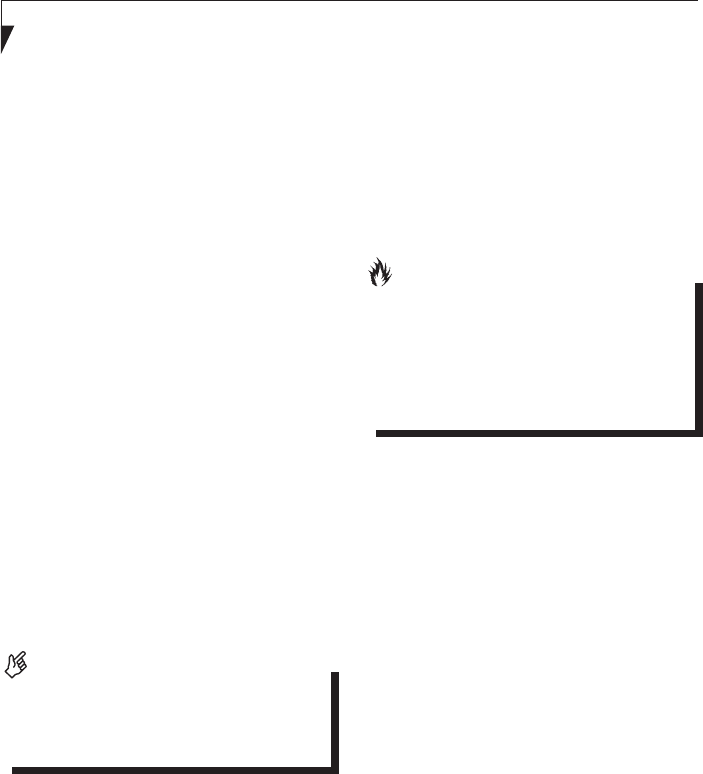
12
Windows Power Management
The Power Options icon located in the Windows
Control Panel allows you to confi gure some of
the power management settings. For example,
you can use the Power Options to set the timeout
values for turning off the display and hard disks
whether you are running the notebook on battery
power or one of the adapters.
Restarting The System
If your system is on and you need to restart it, be
sure that you use the following procedure.
Windows 10
If your system is on and you need to restart it, be
sure that you use the following procedure.
1. Click the Start button, and then move the
mouse over the right arrow.
2. Select the desired action from the list.
Windows 8
1. Swipe in from the right edge of the screen, and
then tap Settings. (If you're using a mouse,
point to the upper-right corner of the screen,
move the mouse pointer down, and then click
Settings.)
2. Click Power, and select Restart from the list.
Using the correct procedure to shut down from
Windows allows your notebook to complete
its operations and turn off power in the proper
sequence to avoid errors. The proper sequence
Windows 10
1. Click the Start button, and then click Shut
Down.
2. Select the Shut Down option from within the
Windows Shut Down dialog box.
3. Click OK to shut down your notebook.
Windows 8
1. Swipe in from the right edge of the screen,
and then tap Settings.
2. Click Power, and select Shut down from
the list.
If you are going to store your notebook for a
month or more see Care and Maintenance
Section.
Power Off
Before turning off the power, check that the
hard drive/ optical drive access indicator is off.
If you turn off the power while accessing a disk
there is a risk of data loss. To ensure that your
notebook shuts down without error, use the
Windows shut down procedure.
When the power is turned off, the status
display LEDs are all OFF except for
during battery charging.
IMPORTANT
CAUTION
Be sure to close all fi les, exit all applications,
and shut down your operating system prior
to turning off the power. If fi les are open
when you turn the power off, you will lose any
changes that have not been saved, and may
cause disk errors.
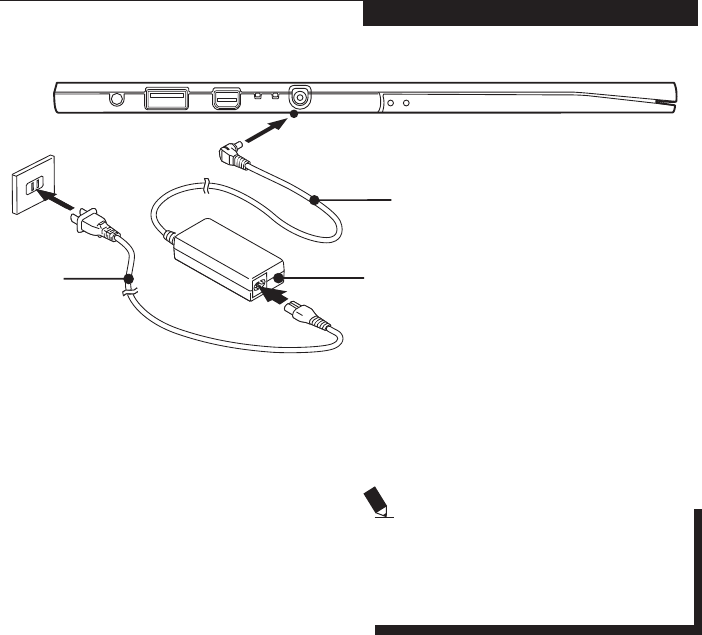
13
DC Power Jack
AC Cable AC Adapter
DC Output Cable
(This picture is for illustration purpose only and may look different from the actual unit)
POWER SOURCES
Connecting the Power
Adapter
The AC adapter provides power for operating
your notebook and charging the batteries.
Connecting the AC Adapter
1. Plug the DC output cable into the DC power
jack on your notebook.
2. Plug the AC adapter into an AC electrical
outlet.
POWER SOURCES
The Li-ion battery is not charged at the point
of purchase. Remember to connect an AC
adapter to your notebook to charge it when
you use it for the fi rst time.
POINT
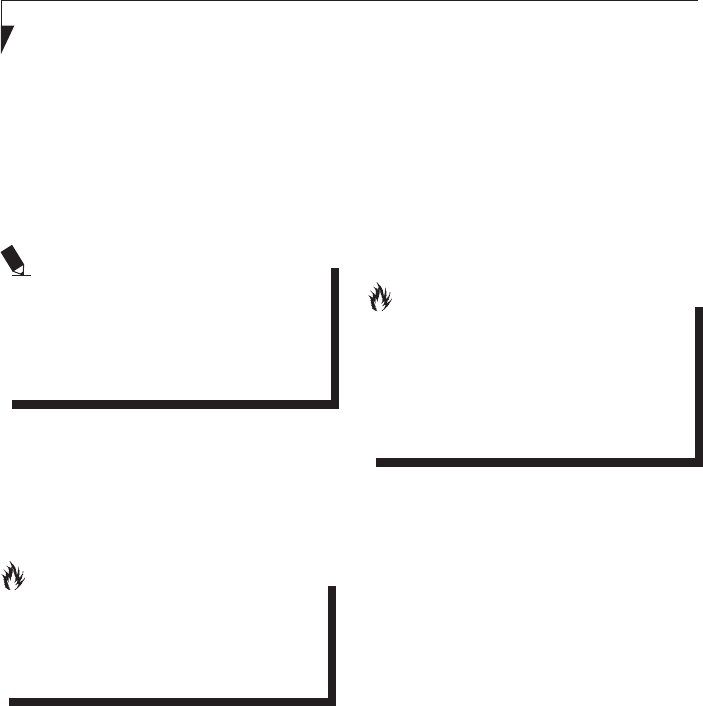
14
Power On
Power/Suspend/Resume button
You can use the Power/Suspend/Resume
button to turn on your notebook. Once you have
connected an AC adapter to the notebook or
charged the internal Lithium ion battery, you can
power on your notebook.
You can press the Power/Suspend/Resume
button to turn off the notebook. After you have
finished working on the notebook, you can
either leave it in Standby (i.e. suspend) mode
or turn it off.
Power Off
Before turning off the power, check that the
Hard Disk Drive Access and Optical Disk Drive
Access indicators are off. If you power off the
notebook when it is accessing the disk drives,
data may be lost or corrupted. To power off
the notebook, always shut down the notebook
properly using the Windows shutdown
procedure.
When you turn on your notebook, be sure
you have a power source connected to
it. This means that at least one battery is
installed and charged or that the AC adapter
is connected and has power.
POINT
CAUTION
Do not carry the notebook around when it is
still power on. Do not subject the notebook to
shocks and vibrations. Failure to do so may
damage the notebook.
When you power on your notebook, it will
perform a Power On Self Test (POST) to
check the internal parts and confi guration
for normal functionality. If an error is found,
your notebook will emit an audio warning
and/or show an error message.
After satisfactory completion of the Power
On Self Test (POST), your notebook will load
your operating system.
CAUTION
Remember to close all files, exit all
applications and shut down the operating
system prior to turning off the power using
the power button. If documents are opened
when the notebook is turned off, data may be
lost and this may result in disk errors.
Remember to use the correct procedure to shut
down the notebook. The proper procedure is:
Windows 10
1. Click the Start button, and then click Shut
Down.
2. Select the Shut Down option from within the
Windows Shut Down dialog box.
3. Click OK to shut down your notebook.
Windows 8
1. Swipe in from the right edge of the screen,
and then tap Settings.
2. Click Power, and select Shut down from
the list.
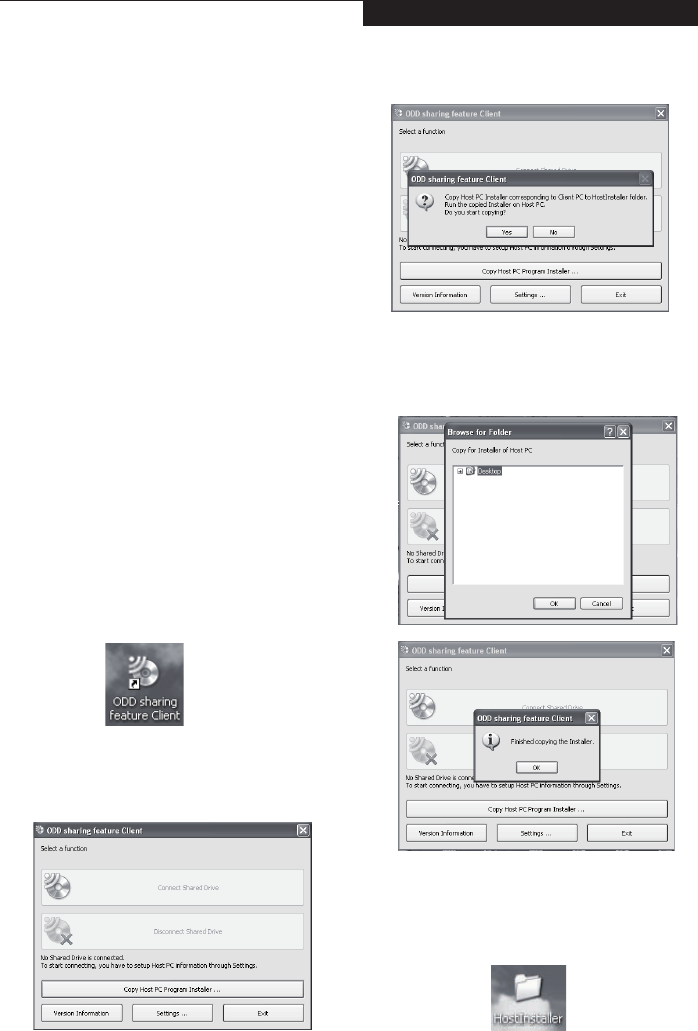
15
GETTING TO START DVD
SHARING APPLICATION
To enjoy this feature, you should
have 2 PC (Host PC and Client PC)
on hand.
• “Host PC”, it refers to a PC which shares
information in CD/DVD drive.
• “Client PC”, it refers to a PC which access
shared CD/DVD drive through a network.
Not supported by DVD Sharing
Application
• Play music CDs or movie DVDs which saved in
shared drive on Host PC.
• Overwrite in shared drive on Host PC.
For user’s PC share the same
Internet Network:
Steps to install “ODD sharing feature Client”,
those steps must be carried out on Client PC:
1. Click “ODD sharing feature Client” icon on
Desktop, then menu screen appears.
2. On the menu screen, to set up connection with
“Host PC”, you have to click “Copy Host PC
Program Installer” button.
3. Click “Yes” to start copying.
4. Select the location to save the “HostInstaller”,
and follow the instructions to proceed.
5. Below folder “HostInstaller” appears on
selected location. Copy the folder, and transfer
it to the Host PC through USB storage disk
etc.
Getting to start DVD sharing Application
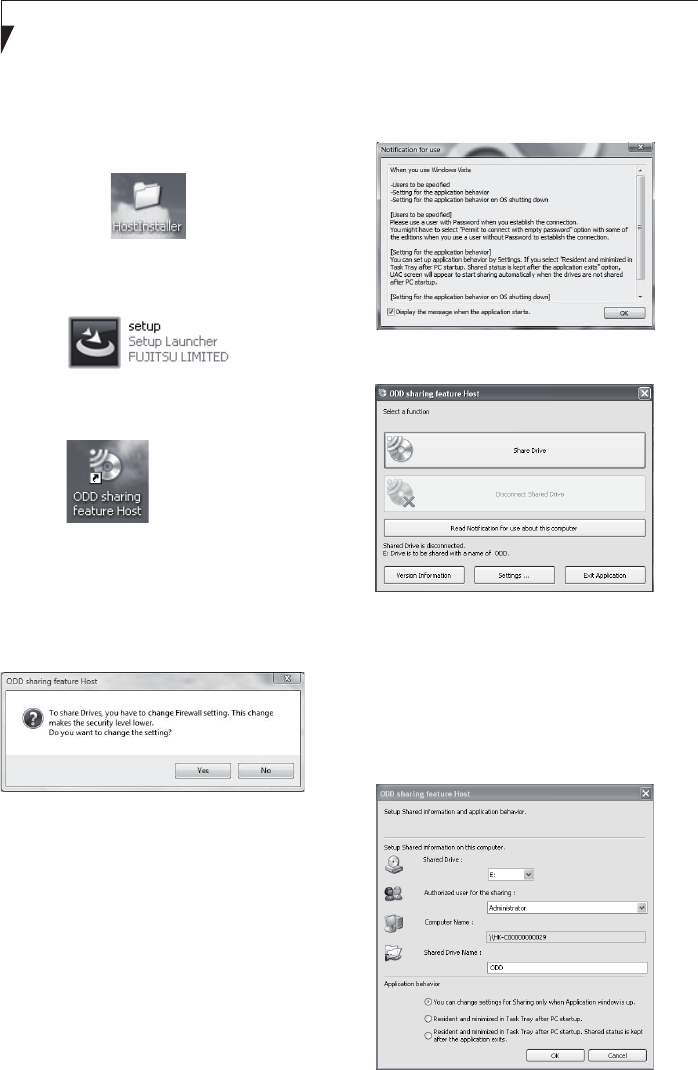
16
Steps to install “ODD sharing feature Host”,
those steps must be carried out on Host PC:
1. Open the folder HostInstaller copied from
Client PC.
2. Click “Setup” to start the installation on Host
PC and follow the instructions on the screen.
3. After installation, click “ODD sharing feature
Host” icon on Desktop.
5. Menu screen appears, click the icon, “Notifi
cation for use” pop-up menu appears, then
click “OK” to continue.
6. On the menu, click “Settings”.
4. To share Drives, you have to click “Yes” to
change the Firewall setting and make the
security level lower, this may make your PC
more vulnerable to viruses and intruders.
Fujitsu is not liable for any data and personal
loss as a result of this change.
7. Choose “Share Drive” and “Authorized user
for the sharing”, type in “Sharing Drive Name”,
e.g. “ODD”. You can also select the desired
“Application Behavior”. After that, click “OK”
and back to “ODD sharing feature Host”
menu.
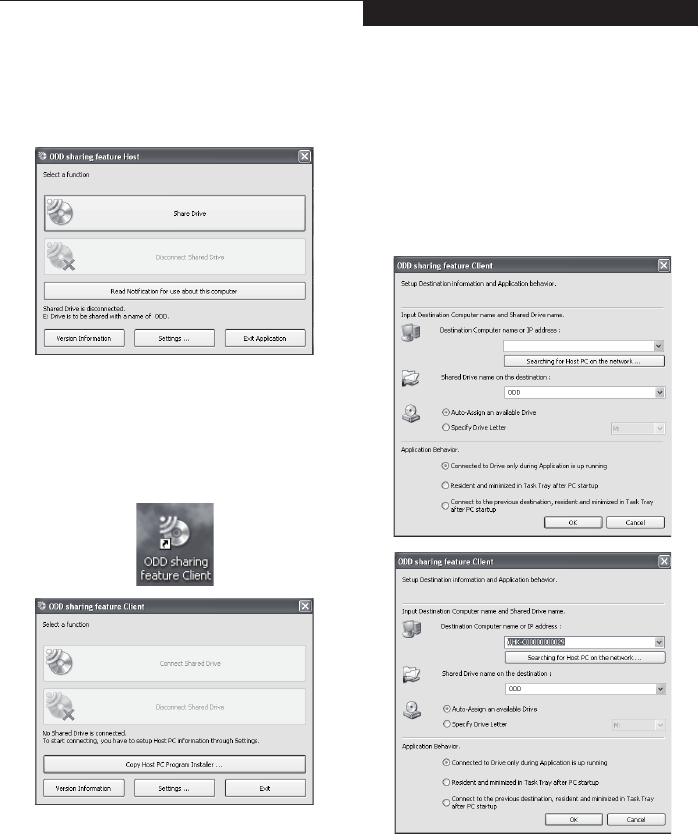
17
8. Click “Share Drive” button. “User Account
Control Menu” appears. Click “Continue” to
proceed.
2. Click “Settings” button, then click “Searching
for Host PC on the network” to auto search
Host PC on the network and type in “Shared
Drive name on the destination” which appears
on setting screen of “ODD sharing feature
Client”. After select the desired Application
Behavior, Click “OK” to confi rm.
Access shared CD/DVD Drive from Client PC
to Host PC, below steps must be carried out
on Client PC.
1. Click “ODD sharing feature Client” icon, and
set up window appears.
Getting to start DVD sharing Application
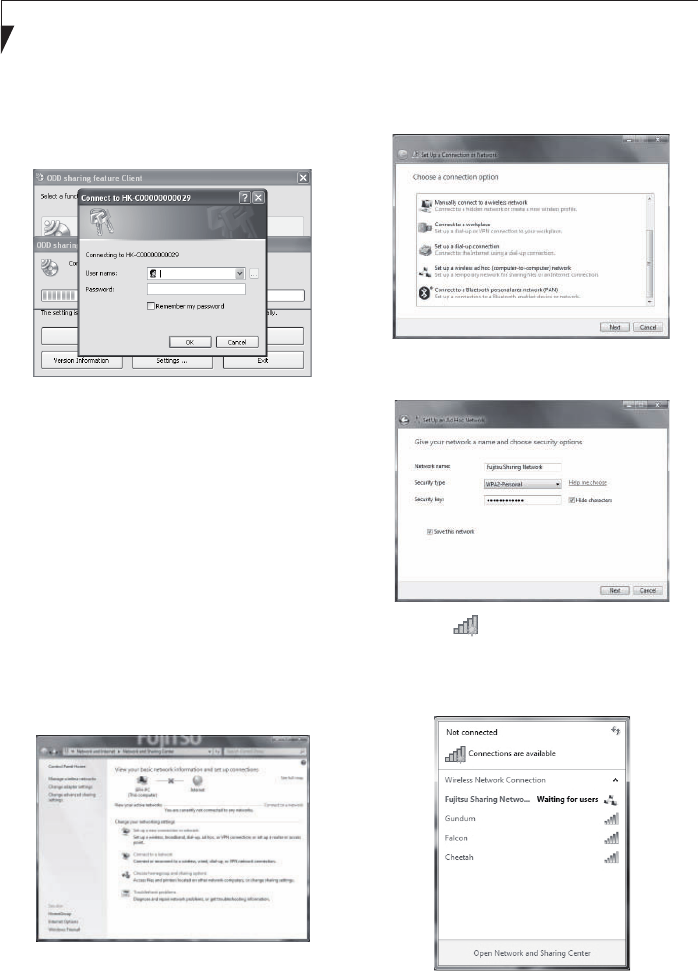
18
3. Enter “User Name” and “Password” of Host
PC user, then click “OK” to connect Host and
Client PC. Client PC user can access Host PC
CD/DVD Drive now.
2. Choose “Set up a wireless ad hoc
(computerto- computer) network”, then click
“Next”.
3. Please fill in the “Network name” and “Security
key”, click “Next” to proceed.
4. Click the logo in Windows Tool Bar to
review network status, you should fi nd the
network created by you and reveal “Waiting
for users”.
For user’s PC cannot access
Internet Network/location or at
places without wireless network
connected, user can establish
ODD sharing network by set up a
wireless ad hoc network,
please ensure you have switched
on the wireless LAN function of
both Client and Host PC.
Below steps must be carried out on Host PC:
1. Go to “Control Panel” → “Network and
Internet” → “Network and Sharing Center”,
then choose “Set up a new connection or
network”.
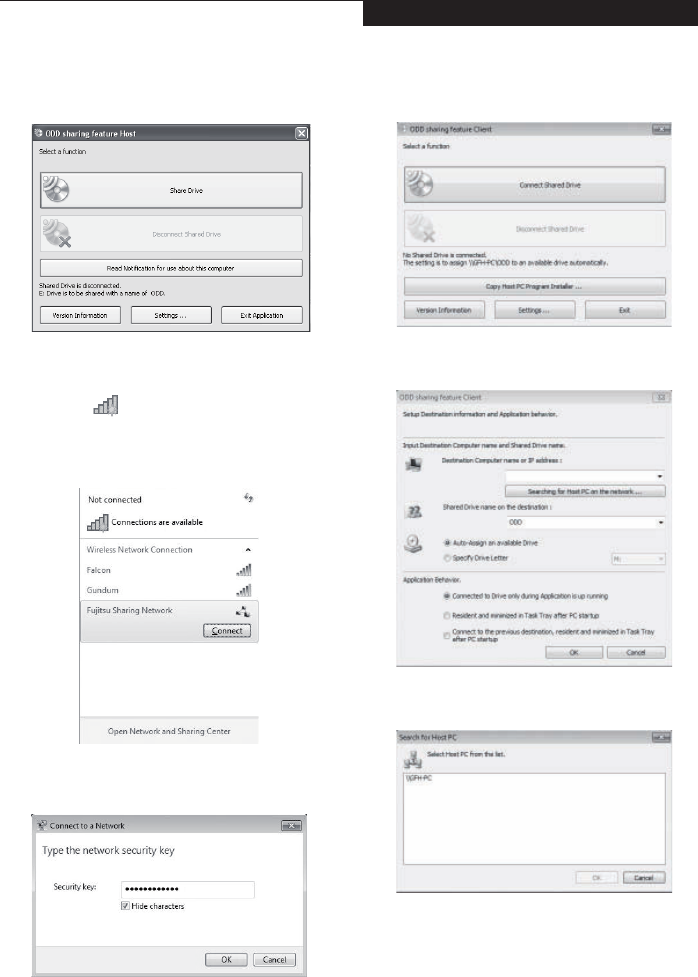
19
5. Run “ODD sharing feature Host” and click
“Share Drive” button in the menu.
3. Run “ODD sharing feature Client”, and click
“Settings”.
4. Click “Searching for Host PC on the network”.
5. Select name of the Host PC from the list and
click “OK”.
2. Type in the “Security key” preset in Host PC
and click “OK” to establish connection.
Below steps must be carried out on Client PC:
1. Click the in Windows Tool Bar to review
all available network, user should fi nd the
network created by Host PC, then click
“Connect” button.
Getting to start DVD sharing Application
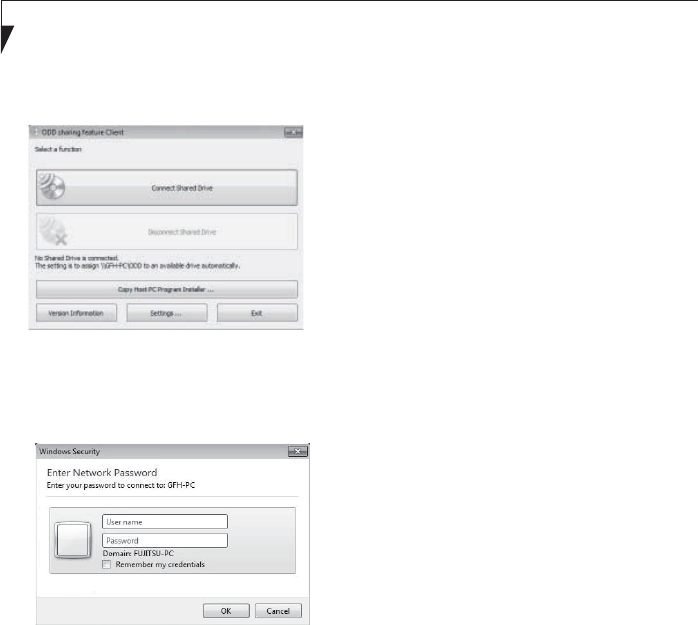
20
6. Go back to the menu, click “Connect Shared
Drive”.
7. Fill in the “User name” and “Password” of the
Host PC, click “OK”. Now, Client PC user can
share the ODD drive of the Host PC.

21
Troubleshooting
TROUBLESHOOTING
Your Fujitsu LifeBook notebook is sturdy and
undergoes stringent reliability tests. However,
you may encounter simple setup or operating
problems that you can solve on the spot or
problems with peripheral devices, that you can
solve by replacing the device. The information in
this section helps you isolate and resolve some
of these straightforward problems and identify
failures that require service.
Identifying the Problem
If you encounter a problem, go through the
following procedure before pursuing complex
troubleshooting:
1. Turn off your LifeBook notebook.
2. Make sure the AC adapter is plugged into your
notebook and to an active AC power source.
3. Make sure that any card installed in the PC
Card slot is seated properly. You can also
remove the card from the slot, thus eliminating
it as a possible cause of failure.
4. Make sure that any devices connected to the
external connectors are plugged in properly.
You can also disconnect such devices, thus
eliminating them as possible causes of failure.
5. Turn on your notebook. Make sure it has been
off at least 10 seconds before you turn it back
on.
6. Go through the boot sequence.
7. If the problem has not been resolved, refer to
the Troubleshooting Table that follows for more
detailed troubleshooting information.
8. If you have tried the solutions suggested in
the Troubleshooting Table without success,
contact your support representative.
Before you place the call, you should have the
following information ready so that the customer
support representative can provide you with the
fastest possible solution:
• Product name
• Product con guration number
• Product serial number
• Purchase date
• Conditions under which the problem occurred
• Any error messages that have occurred
• Hardware con guration
• Type of device connected, if any
See the Confi guration Label on the bottom
of your notebook for confi guration and serial
numbers.
Specific Problems
Using the Troubleshooting Table
When you have problems with your LifeBook
notebook, try to find the symptoms under the
Problem column of the troubleshooting table.
You will fi nd a description of common causes
for that symptom under the column Possible
Cause. Follow the instructions on the Possible
Solution column to resolve the problem. All
possible causes or solutions may not apply to
your notebook.
If you keep notes about what you have tried,
your support representative may be able to
help you more quickly by giving additional
suggestions over the phone.
POINT

22
Troubleshooting Table
Problem
Audio Problem
DVD/CD-RW/CD-ROM Drive Problems
There is no sound
coming from the
built-in speakers.
LifeBook notebook
fails to recognize
DVD/CD-RW/
CDROM’s.
(continued)
The software volume
control is set too low.
Protective sheet is still
in the DVD/CD-RW/CD-
ROM
drive tray.
DVD/CD-RW/CD-ROM
is not pushed down onto
raised center circle of the
drive.
DVD/CD-RW/CD-ROM
tray is not latched shut.
Incorrect DVD Player or
no DVD Player software
is installed.
Headphones are plugged
into your notebook.
BIOS audio settings
are incorrect.
Software driver is not
confi gured correctly.
The speakers have been
muted using the Volume
icon in the system tray.
Adjust the sound volume control settings
in your software, operating system and
applications.
Remove the protective sheet from the DVD/
CD-RW/CDROM drive tray.
Open DVD/CD-RW/CD-ROM tray and reinstall
DVD/CD-RW/CD-ROM properly.
Push on the front of the DVD/CD-RW/CDROM
tray until it latches.
Install DVD Player software.
Plugging in headphones disables the built-in
speakers, remove the headphones.
Set the BIOS setup utility to the default values
within the Multimedia Device Confi guration
menu.
Refer to your application and operating
system documentation for help.
Click on the Volume icon in the tool tray on
the bottom right of the screen. (It looks like a
speaker).
If the Mute box is checked, click on it to
uncheck it.
Possible Cause Possible Solution
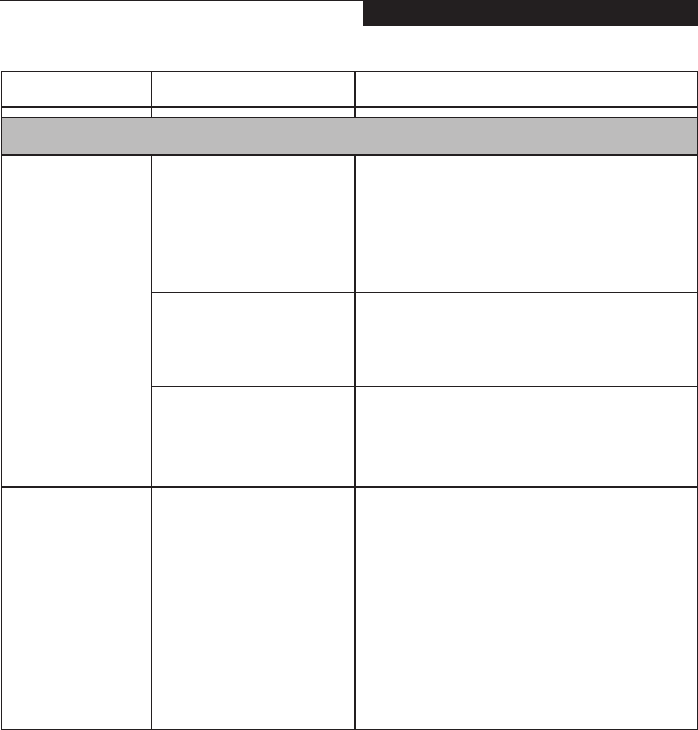
23
Troubleshooting
Problem
DVD/CD-RW/CD-ROM Drive Problems
LifeBook notebook
fails to recognize
DVD/CD-RW/
CDROM’s.
The DVD/CD-RW/
CD-ROM Access
indicator on the
Status Indicator
Panel blinks at
regular intervals
when no DVD/
CD-RW/CD-ROM
is in the tray or the
optical drive is not
installed.
Wrong drive designator
was used for DVD/
CDRW/CD-ROM in the
application.
The Windows DVD/
CD-RW/CD-ROM auto
insertion function is active
and is checking to see if
a DVD/CD-RW/CD-ROM
is ready to run.
Windows DVD/CD-RW/
CD-ROM auto insertion
function is disabled.
DVD/CD-RW/CD-ROM is
dirty or defective.
Verify the drive designator used by the
application is the same as the one used by the
operating system.
When the operating system is booted from a
DVD/ CD, drive designations are automatically
adjusted.
This is normal. However, you may disable this
feature.
Start the DVD/CD-RW/CD-ROM from the
desktop or application software or re-enable
the Windows DVD/CD-RW/CD-ROM auto
insertion function.
Wipe DVD/CD-RW/CD-ROM with a
nonabrasive CD cleaning cloth and reinsert. If it
still does not work, replace a new DVD/CDRW/
CD-ROM in the drive.
Possible Cause Possible Solution

24
Problem
Floppy Disk Drive Problems
Hard Drive Problems
Keyboard or Mouse Problems
You cannot access
your oppy disk.
You cannot access
your hard drive.
The built-in
keyboard does
not seem to work.
You tried to write to a
write protected oppy
disk.
The setup utility is
incorrectly set for your
internal (Primary Master)
or optional second hard
drive (Primary Slave).
The notebook has gone
into Suspend mode.
Your application has
locked out your keyboard.
The wrong drive
designator was used by
an application when a
bootable CD-ROM was
used to start the
notebook.
Security is set so your
operating system cannot
be started without a
password.
Floppy disk is not
loaded correctly.
The oppy disk drive may
not be properly installed.
Security is set to protect
access to oppy disk
data.
Eject the oppy disk and set it to write enable.
Revise BIOS settings to set both Primary
Master and Primary Slave correctly.
Push the Power/Suspend/Resume button.
Try to use your integrated pointing device to
restart your system.
Verify drive designator used by application
is in use by the operating system. When the
operating system is booted from a CD, drive
designations are automatically adjusted.
Verify your password and security settings.
Eject oppy disk, check orientation and
reinsert.
Remove and re-install your oppy disk drive.
Verify your password and security settings.
Possible Cause Possible Solution
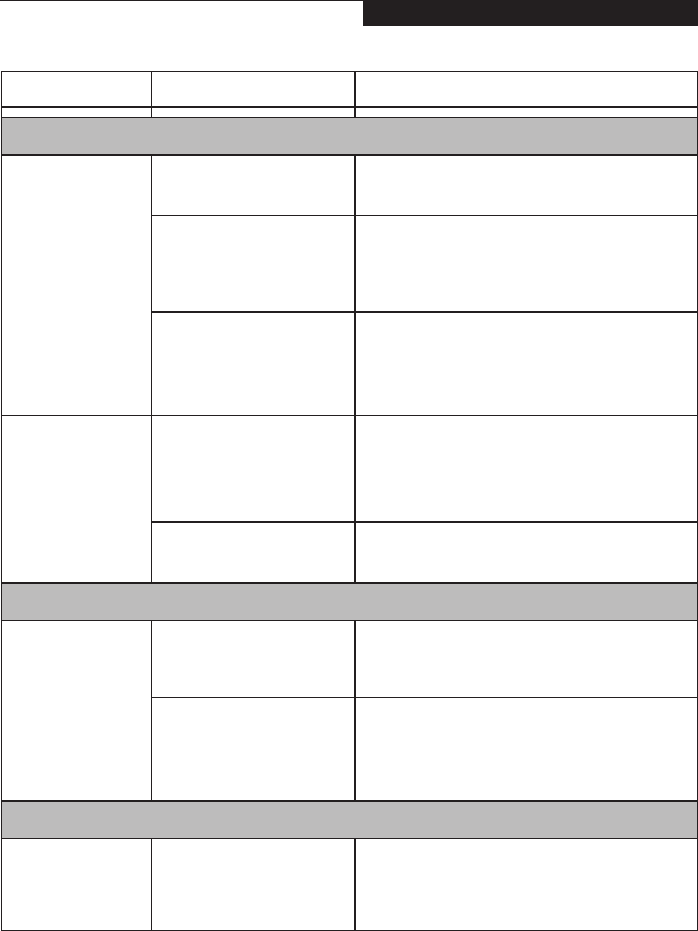
25
Problem
Keyboard or Mouse Problems
Memory Problems
Modem Problems
You have installed
an external
keyboard or
mouse, and it
does not seem to
work.
You have
connected an
external keyboard
or a mouse and
it seems to be
locking up the
system.
Your Power On
screen, or Main
menu of the BIOS
setup utility
information, does
not show the
correct amount of
installed memory.
Messages about
modem operation.
Your external device is
not properly installed.
Your operating system
software is not setup
with the correct software
driver for that device.
Your system has crashed.
Your memory upgrade
module is not properly
installed.
Messages about modem
operation are generated
by whichever modem
application is in use.
You have a memory
failure.
Your operating system
software is not setup
with the correct software
driver for that device.
Your mouse or keyboard
is connected to the
wrong PS/2 port on the
optional Port Replicator.
Re-install your device.
Check your device and operating system
documentation and activate the proper driver.
Try to restart your notebook.
Remove and re-install your memory upgrade
module.
See your application software documentation
for additional information.
Check for Power On Self Test (POST)
messages.
Check your device and operating system
documentation and activate the proper driver.
Plug the mouse into the PS/2 Mouse port and
the external keyboard or numeric key pad into
the PS/2 Keyboard port.
Possible Cause Possible Solution
Troubleshooting

26
Problem
PC Card Problems
Power Failures
A card inserted in
the PC Card slot
does not work or
is locking up the
system.
You turn on your
LifeBook notebook
and nothing
seems to happen.
(continued)
The card is not properly
installed.
The installed primary
battery is completely
discharged, there is no
optional second battery
installed or there is no
Power adapter (AC
adapter) installed.
The primary battery is
installed but is faulty.
The battery or batteries
are low.
The power adapter (AC
adapter) is not plugged
in properly.
Your PC Card device
and another device are
assigned the same I/O
address.
The card may have
been installed while an
application was running,
so your notebook is not
aware of its installation.
Your software may not
have the correct software
driver active.
You may have the wrong
I/O address selected for
the activated PC Card.
Remove and re-install the card.
Check the Status Indicator Panel to determine
the presence and condition of the batteries.
Install a charged battery or a Power adapter.
Use the Status Indicator panel to verify the
presence and condition of the batteries. If
a battery is indicating a short, remove that
battery and operate from another power
source or replace that battery.
Check the Status Indicator Panel to determine
the presence and condition of the batteries.
Use a Power adapter to operate until a battery
is charged or install a charged battery.
Verify that your adapter is connected correctly.
Check all I/O addresses located within the
BIOS setup utility and any other installed
hardware or software to make sure there are
no duplications.
Close the application and restart your
notebook.
See your software documentation and activate
the correct driver.
See your PC Card documentation to
determine the required I/O address. Change
the settings in the BIOS.
Possible Cause Possible Solution

27
Troubleshooting
Problem
Power Failures
You turn on your
LifeBook notebook
and nothing
seems to happen.
Your LifeBook
notebook turns off
all by itself.
The power adapter (AC
adapter) has no power
from the AC outlet.
The power management
parameters are set for
auto timeouts which
are too short for your
operating needs.
You are operating on
battery power only and
have ignored a low
battery alarm until the
batteries are all power
drained empty and your
machine has gone into
Dead Battery Suspend
mode.
You have a battery failure.
Your power adapter has
failed or lost its power
source.
The power adapter (AC
adapter) is faulty.
Move the AC cord to a different outlet, check
for a line switch or tripped circuit breaker for
the AC outlet.
Press any button on the keyboard, or move
the mouse to restore operation. If that fails,
push the Power/Suspend/Resume button.
Check your power management settings, or
close your applications and go to the Power
Options menu to adjust the timeout values to
better suit your needs.
Install a power adapter or a charged battery
and then push the Power/Suspend/Resume
button.
Verify the condition of the batteries using the
Status Indicator Panel, and replace or remove
battery that is shorted
Make sure the adapter is plugged in and the
outlet has power.
Try a different power adapter or install a
charged optional second battery.
Possible Cause Possible Solution

28
Problem
Power Failures
Your LifeBook
notebook will not
work on battery
alone.
The batteries
seem to discharge
too quickly.
The installed batteries
are dead.
You are running an
application that uses a
great deal of power due
to frequent hard drive
access or DVD/CD-ROM
access, use of a modem
card or a LAN PC card.
The power savings
features may be disabled.
The brightness is turned
all the way up.
The batteries are very old.
The batteries have been
exposed to high
temperatures.
The batteries are too hot
or too cold.
No batteries are installed.
The batteries are
improperly installed.
Your installed batteries
are faulty.
Replace the battery with a charged one or
install a Power adapter.
Use both the primary battery and an optional
second battery and/or use a power adapter for
this application when at all possible.
Check the power management and/or setup
utility settings in the Power Savings menu and
adjust according to your operating needs.
Turn down the brightness adjustment. The
higher the brightness the more power your
display uses.
Replace the batteries.
Replace the batteries.
Restore the notebook to normal operating
temperature. The Charging icon on the Status
Indicator panel will ash when the battery is
outside its operating range.
Install a charged battery.
Verify that the batteries are properly
connected by re-installing them.
Verify the condition of the batteries using the
Status Indicator panel and replace or remove
any batteries that are shorted.
Possible Cause Possible Solution

29
Troubleshooting
Problem
Shutdown and Startup Problems
The Suspend/
Resume button
does not work.
The system
powers up, and
displays power on
information, but
fails to load the
operating system.
An error message
is displayed on the
screen during the
notebook (boot)
sequence.
The Suspend/Resume
button is disabled from
the Advanced submenu
of the Power menu of the
setup utility.
The boot sequence
settings of the setup
utility are not compatible
with your confi guration.
Power On Self Test
(POST) has detected a
problem.
You did not hold the
button in long enough.
There may be a conict
with the application
software.
You have a secured
system requiring a
password to load your
operating system.
Internal hard drive was
not detected.
Enable the button from the setup utility.
Set the operating source by pressing the
[ESC] key while the Fujitsu logo is on screen
or use the [F2] key and enter the setup utility
and adjust the source settings from the Boot
menu.
See the Power On Self Test (POST)
messages to determine the meaning and
severity of the problem.
Not all messages are errors; some are simply
status indicators.
Hold the button longer. This may need to be a
few seconds if your application is preventing
the CPU from checking for button pushes.
Close all applications and try the button again.
Make sure you have the right password. Enter
the setup utility and verify the Security settings
and modify them as accordingly.
Use the BIOS setup utility or Primary Master
submenu, located within the Main menu, to try
to auto detect the internal hard drive.
Possible Cause Possible Solution
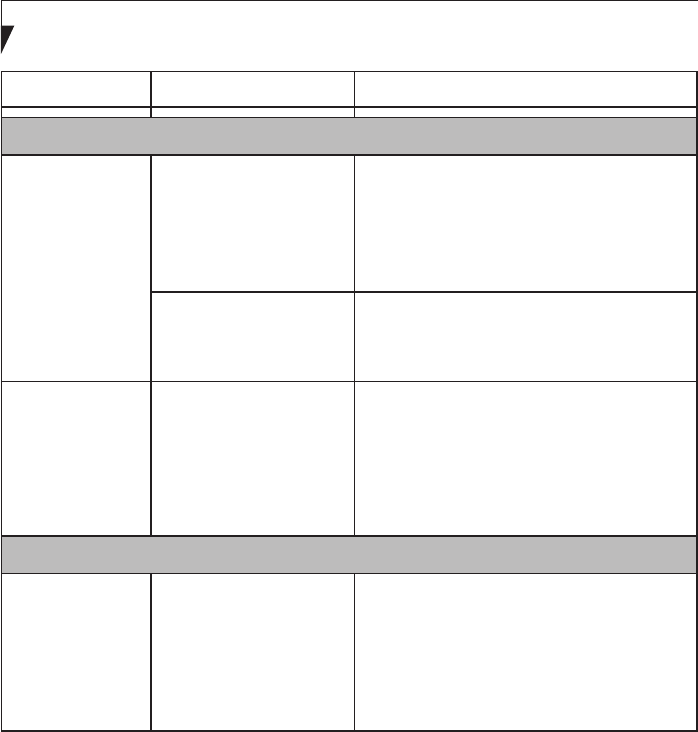
30
Problem
Shutdown and Startup Problems
Video Problems
Your notebook
appears to change
setup parameters
when you start it.
The built-in
display is blank
when you turn
on your LifeBook
notebook.
(continued)
Your system
display won’t
turn on when the
system is turned
on or when the
system has
resumed.
BIOS setup changes
were not saved when you
made them and exited
the BIOS
setup utility returning it to
pevious settings.
Something is pushing on
the Closed Cover switch.
The system may be
password-protected.
The BIOS CMOS hold-up
battery has failed.
Make sure you select Save Changes And Exit
when exiting the BIOS setup utility.
Clear the Closed Cover switch.
Check the status indicator panel to verify that
the Security icon is blinking. If it is blinking,
enter your password.
Contact your support representative for
repairs.
This is not a user serviceable part but has a
normal life of 3 to 5 years.
Possible Cause Possible Solution

31
Troubleshooting
Problem
Video Problems
The built-in
display is blank
when you turn
on your LifeBook
notebook.
The LifeBook
notebook turned
on with a series of
beeps and your
built-in display is
blank.
The display goes
blank by itself after
you have been
using it.
The notebook is set for
an external monitor only.
Power On Self Test
(POST) has detected
a failure which does
not allow the display to
operate.
The notebook has gone
into Video Timeout,
Standby mode, Suspend
mode or Save-to-Disk
mode because you have
not used it for a period of
time.
The angle of the display
and the brightness
settings are not dequate
for your lighting
conditions.
The power management
time-outs may be set for
very short intervals and
you failed to notice the
display come on and go
off again.
The power management
time-outs may be set for
very short intervals and
you failed to notice the
display come on and go
off again.
Something is pushing on
the Closed Cover switch.
Pressing [F10] while holding down the [Fn]
key allows you to change your selection of
where to send your display video. Each time
you press the combination of keys you will
step to the next choice. The choices, in order
are: built-in display only, external monitor only,
both built-in display and external monitor.
Contact your support representative.
Press any button on the keyboard, or move
the mouse to restore operation. If that fails,
push the Power/Suspend/Resume button.
Check your power management settings, or
close your applications and go to the Power
Savings menu of the setup utility to adjust the
timeout values to better suit your operation
needs.
Move the display and the brightness control
until you have adequate visibility.
Press any button the keyboard, or move the
mouse to restore operation. If that fails, push
the Power/Suspend/Resume button. (The
display may be shut off by Stanby mode, Auto
Suspend or Video Timeout)
Press any button on the keyboard, or move
the mouse to restore operation. If that fails,
push the Power/Suspend/Resume button.
(The display may be shut off by Standby
Mode, Auto Suspend or Video Timeout)
Check the Closed Cover switch.
Possible Cause Possible Solution

32
Problem
Video Problems
Miscellaneous Problems
The application
display uses only
a portion of your
screen and is
surrounded by a
dark frame.
An error message
is displayed on the
screen during the
operation of an
application.
The Display is
dark when on
battery power.
You have
connected an
external monitor
and it does not
display any
information.
You have
connected an
external monitor
and it does not
come on.
You are running an
application that does not
support 800 x 600/1024
x 768 pixel resolution
display and display
compression is enabled.
Application software often
has its own set of error
message displays.
The Power Management
utility default is set on low
brightness to conserve
power.
Your BIOS setup is
not set to enable your
external monitor.
Your external monitor is
not compatible with your
LifeBook notebook.
Your external monitor is
not properly installed.
Your operating system
software is not setup
with the correct software
driver for that device.
Display compression gives a clearer but
smaller display for applications that do not
support 800 x 600/1024 x 768 pixel resolution.
You can fi ll the screen but have less resolution
by changing your display compression setting,
(See the Video Features submenu, located
within the Advanced menu of the BIOS.)
See your application manual and help display
screens for more information. Not all
messages are errors. Some may simply be
status messages.
Press [Fn] + [F7] to increase brightness or
double- click on the battery gauge and adjust
Power Control under battery settings.
Try toggling the video destination by pressing
[Fn] and [F10] together, or check your BIOS
setup and enable your external monitor. (See
the Video Features submenu, located within
the Advanced Menu of the BIOS.)
See your monitor documentation and the
External Monitor Support portions of the
Specifi cations section.
Reinstall your device.
Check your device and operating system
documentation and activate the proper driver.
Possible Cause Possible Solution

「FOMA」「Xi」は NTT ドコモの商標または登録商標です。
その他の各製品名は、各社の商標、または登録商標です。
その他の各製品は、各社の著作物です。
Copyright FUJITSU LIMITED 20165
CPxxxxxx
データ通信端末の比吸収率(SAR)
この機種 ARROWS TabLIFEBOOK R726/Mは、国が定めた電波の人体吸収に関する技術基準および電波防護
の国際ガイドラインに適合しています。
このデータ通信端末は、国が定めた電波の人体吸収に関する技術基準※1ならびに、これと同等な国際ガイドライン
が推奨する電波防護の許容値を遵守するよう設計されています。この国際ガイドラインは世界保健機関(WHO)と
協力関係にある国際非電離放射線防護委員会(ICNIRP)が定めたものであり、その許容値は使用者の年齢や健
康状況に関係なく十分な安全率を含んでいます。
国の技術基準および国際ガイドラインは電波防護の許容値を人体に吸収される電波の平均エネルギー量を表す
比吸収率(SAR:Specific Absorption Rate)で定めており、本データ通信端末に対するSARの許容値は2.0W/kg
です。取扱説明書に記述する通常使用の場合、このデータ通信端末のSARの最大値0.701W/kg※2です。個々の
製品によってSARに多少の差異が生じることもありますが、いずれも許容値を満足しています。
データ通信端末は、携帯電話など基地局との通信に必要な最低限の送信電力になるよう設計されているため、実
際に通信している状態では、通常SARはより小さい値となります。一般的には、基地局からの距離が近いほど、デ
ータ通信端末の出力は小さくなります。
通信中は、身体から1.5センチ以上離し、かつその間に金属(部分)が含まれないようにしてください。このことによ
り、本データ通信端末が国の技術基準および電波防護の国際ガイドラインに適合していることを確認しています。
世界保健機関は、『携帯電話が潜在的な健康リスクをもたらすかどうかを評価するために、これまで20年以上にわ
たって多数の研究が行われてきました。今日まで、携帯電話使用によって生じるとされる、いかなる健康影響も確
立されていません。』と表明しています。
さらに詳しい情報をお知りになりたい場合には世界保健機関のホームページをご参照ください。
http://www.who.int/docstore/peh-emf/publications/facts_press/fact_japanese.htm
SARについて、さらに詳しい情報をお知りになりたい方は、次のホームページをご参照ください。
総務省のホームページ http://www.tele.soumu.go.jp/j/sys/ele/index.htm
一般社団法人電波産業会のホームページ http://www.arib-emf.org/index02.html
※1技術基準については、電波法関連省令(無線設備規則第14条の2)で規定されています。
※2 Xi/FOMAと同時に使用可能な無線機能を含みます。